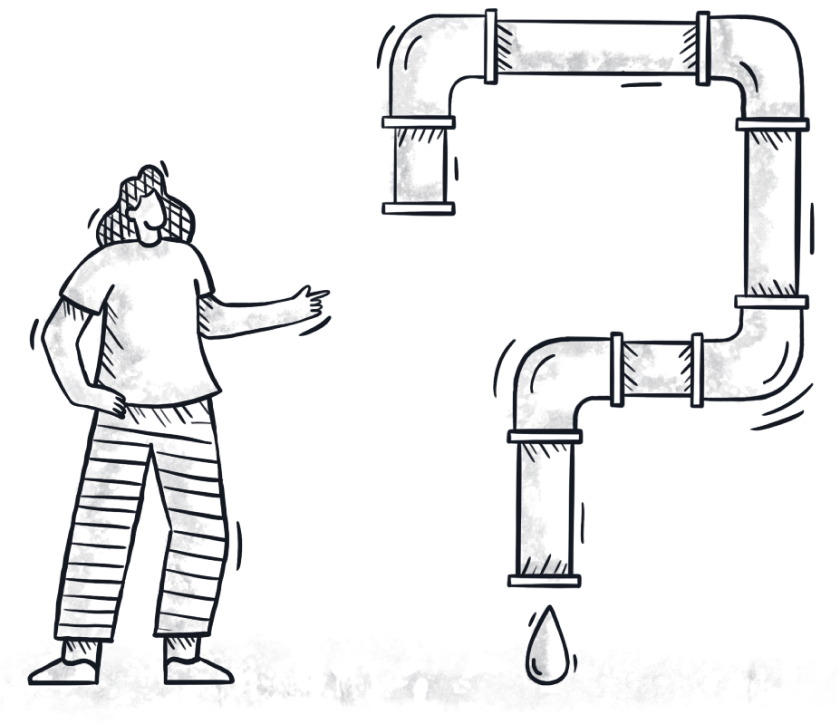Implementation Monitoring
Monitoring the implementation of sanitation interventions plays a key role in achieving programme objectives and ensuring that activities are being delivered as planned. Monitoring is the operational tracking of progress towards agreed outputs. It enables the identification of corrective measures, if needed. Monitoring aims to ensure that interventions are timely, adequate and meet the needs of the affected population, ultimately contributing to the achievement of the intended project outcomes and accountability to stakeholders.
Key steps for implementation monitoring of sanitation interventions are:
-
- Develop an Implementation Plan: this is a list of all project activities and tasks, a budget and a time frame describing when each activity should be completed and who is responsible
-
- Define indicators to measure progress: agree on how an activity or task is to be completed and what needs to be monitored. Develop indicators to measure the progress and performance of the expected outputs/deliverables (based on the implementation plan). Indicators should be SMART – Specific, Measurable, Attainable, Relevant and Time-bound
-
- Develop a detailed monitoring plan: describe the methodology for collecting data, the frequency of data collection (e.g. weekly site visits), the tools to be used to collect the data, how the findings will be documented and who is responsible for monitoring
-
- Collect and analyse monitoring data: conduct regular site visits and continuously collect monitoring data based on the monitoring plan. Once the monitoring data has been collected, it should be analysed to evaluate the results of the sanitation interventions, identifying successes and areas for improvement. All stakeholders, including community members, government officials and sanitation experts should be engaged in the monitoring process to ensure that their feedback and perspectives are considered. Their engagement may include community meetings, surveys and other forms of consultation
-
- Provide regular progress updates: inform all project stakeholders (including communities, local government and donors) about the progress (and delays) in project implementation at regular intervals (for example every two weeks). For reporting purposes, it may be useful to document who was informed and when. Engage with the community to get their feedback on the project’s progress and performance. Community members can provide valuable insights into the project’s effectiveness and identify key challenges to address
-
- Inform programming and take corrective actions if necessary: use the monitoring results to inform decision-making. If the monitoring (or Evaluation) reveals areas for improvement, corrective actions should be taken to address any identified gaps or issues. This could include modifying the project design, adjusting the implementation approach or investing additional resources to improve the project’s effectiveness.
A sanitation intervention involves several stages, including the Planning, Design and Construction and Operation and Maintenance of the sanitation facilities. Regular monitoring is required to ensure the technical integrity of the interventions, track progress towards objectives and the performance, quality and results of sanitation interventions.
Monitoring during and after sanitation interventions is essential to ensure consistent quality, compliance with regulations, safety, process optimisation and accountability. Without a proper monitoring system in place, the effectiveness and sustainability of sanitation interventions cannot be ensured.
A sanitation intervention requires a robust monitoring system, often using a comprehensive implementation plan to coordinate all project tasks and a monitoring framework with corresponding indicators and clear roles and responsibilities for the project implementation. An Implementation Plan is a detailed list of activities required to achieve the objectives of a sanitation intervention, including a Budget, Resource Requirements and a time frame. It serves as an orientation for project implementation and as a reference to track progress towards objectives, enabling project managers to monitor whether the project is on track during its implementation. To an extent, an Implementation Plan earmarks project resources for specific activities. It helps to prevent manipulation or misuse because any reallocation of funds and other resources should ideally be documented and justified.
Implementation monitoring involves data collection and analysis by skilled personnel and tracking of progress against predetermined indicators and targets, taking corrective actions when necessary.
Routine monitoring should start immediately during the emergency phase and be continued after implementation (post-implementation monitoring), regardless of whether the context is emergency, post-emergency, camp-based, non-camp-based, urban, or rural.
Effective implementation monitoring also requires a collaborative effort involving various stakeholders, including the affected communities, government, non-governmental organisations (NGOs) and private sector partners.
Examples of good quality guidelines for monitoring humanitarian sanitation programmes can be found under ‘key resources’.
-
Bibliography
Key Resources and Tools
Establish Implementation Plan and Progress Monitoring
Guidance on how to develop an implementation plan and monitoring framework, including an example template
WASH Monitoring System. Briefing Note
Briefing note on UNHCR’s WASH monitoring approach, in particular why to monitor, when to monitor…
Monitoring and Evaluation. International Federation of Red Cross Red Crescent Societies (IFRC)
IFRC guidelines and tools for monitoring and evaluation (in various languages)
WASH – Post Implementation Monitoring
Summary of different WASH post implementation monitoring approaches (with a focus on development and longer-term…
Kobo survey - desludging monitoring
Sampling for Faecal Sludge and Other Liquid Wastes in Emergency Settings
Summary of methodologies for FS sampling used in Cox’s Bazar, Bangladesh
Related Common Questions
Found what you were looking for?
Still have questions?
You could not find the information you were looking for? Please contact our helpdesk team of experts for direct and individual support.

